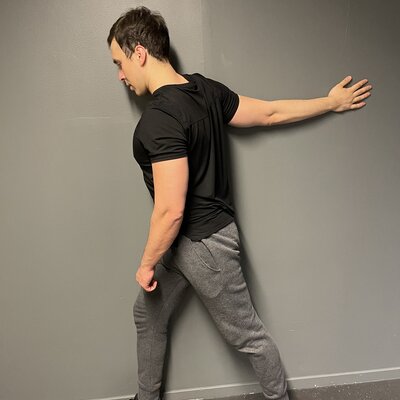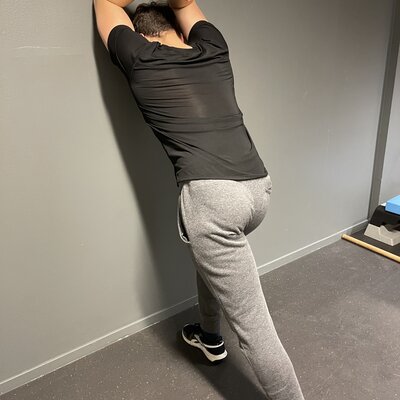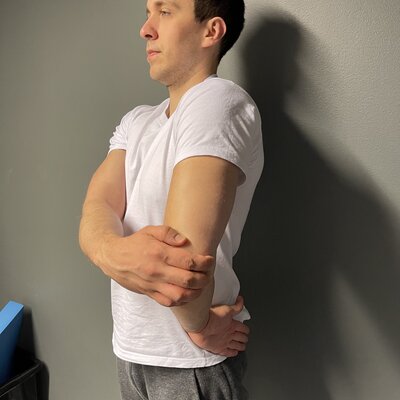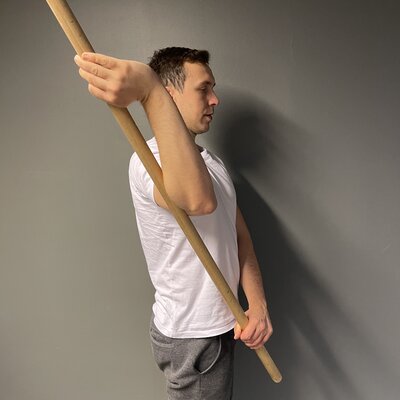PNF Stretching For Shoulder Muscles for Mobility and Stability
In this article, I will show you PNF stretching for shoulder mobility and stability that will improve the function of your shoulders and upper body.
You will learn:
- Hold-relax PNF techniques for shoulder muscles (rotator cuff, lats, chest muscles)
- D1 and D2 patterns for shoulder mobility/stability
- How PNF affects shoulder function
- Tips and safety measures when performing PNF exercises for shoulders
After reading this article, you will be 100% ready to start with PNF shoulder stretching exercises.
PNF Stretching and Shoulder Function
PNF is a set of various techniques that aim to improve the range and efficiency of motion, as well as flexibility and muscle strength in the shoulder.
The shoulder joint is complex and requires a good balance between strength and activation of the rotator cuff muscles to function optimally.
This is where PNF techniques for the shoulder come in, which are scientifically proven to help by:
- Improving the shoulder joint structure in patients with frozen shoulder (adhesive capsulitis) and presenting an effective treatment for this condition.
- Increasing the range of motion in the shoulder joint in the directions of external rotation and abduction
- Improving muscle performance in the shoulder of swimmers in the 50m freestyle event.
This means that by practicing PNF exercises, you will improve shoulder health, mobility, and range of motion, as well as muscle performance.
Let’s see how PNF stretches look in practice.
PNF Stretching for Shoulder Mobility
Now, I will show you the hold-relax technique for shoulder muscles.
PNF Stretching for Pectoral Muscles (Chest)
- Stand with your body against the wall and raise one arm to the height of your shoulder, keeping contact with the wall.
- Slowly rotate your body away from the wall in the opposite direction. Hold that position for 15 seconds.
- Then, tighten your chest muscle by pushing the wall with your hand gently. Hold for 5 seconds.
- Repeat this process 5 times, each time going into a slightly deeper stretch.
PNF Stretching for Lats
- Stand facing the wall with your elbows resting on the wall and your entire body leaning forward.
- Push your chest forward and hold that position for 15 seconds.
- Then, press your elbows down gently without moving them.
- Hold this position for 5 seconds.
- Repeat this process 5 times, each time going into a slightly deeper stretch.
PNF Stretching for Teres Minor
- From a standing position, bend one arm and place your hand on your hip.
- With the opposite arm, grasp the elbow of the bent arm and pull it gently towards yourself.
- Once you find the appropriate intensity of stretching, hold that position for 15 seconds.
- Then, push your arm back with your elbow and hold in that position for 5 seconds.
- Repeat the entire process of stretching and muscle contraction 5 times.
PNF Stretching for Teres Major and Subscapularis
- For this exercise, you will need a yoga stick or something similar stretching tool.
- From a standing position, raise one arm to shoulder height, bend it at a 90-degree angle, and hold the stick with both hands.
- With the lower hand, slowly lift the stick so that the other hand slowly moves in the direction of external rotation in the shoulder.
- When you find the appropriate stretch in the front of your shoulder, hold that position for 15 seconds.
- Then, tighten the muscles of your shoulder as if you are pushing the stick forward.
- Hold in this position for 5 seconds. Repeat the entire process 5 times, going deeper and deeper into the stretch each time.
PNF Diagonals (D1 and D2) for Shoulder
PNF diagonals are diagonal movements in the upper extremities that involve the shoulder, elbow, wrist, and fingers.
In this context, I will focus mainly on the shoulder.
By knowing PNF diagonals, you can effectively exercise the functionality of your shoulders by stretching or strengthening your shoulder muscles through these movements.
There are two diagonals that are important to know.
Both diagonals have positions in flexion and extension.
D1 Diagonal
The flexion position for this diagonal involves flexion, adduction, and external rotation in the shoulder, with the forearm in supination, the wrist and fingers in flexion, and the arm bent at the elbow.
Through this position, you can exercise the following shoulder muscles: deltoid, chest muscles, and teres minor.
The extension position for the D1 diagonal involves extension, abduction, and internal rotation in the shoulder, with the forearm in pronation and the wrist and fingers in extension. The arm is straightened at the elbow.
Through this position, you can exercise the following shoulder muscles: latissimus dorsi, triceps, subscapularis, and teres major.
D2 Diagonal
The flexion position for this diagonal is: flexion, abduction, and external rotation in the shoulder, with the forearm in supination and the elbow extended.
The D2 flexion position primarily activates the trapezius and serratus anterior muscles.
The extension position for this diagonal is: extension, adduction, and internal rotation in the shoulder, with the forearm in pronation and the arm extended. This position is commonly referred to as the “sword-pulling” position. The D2 extension position primarily activates the rotator cuff muscles.
Tips and safety measures when performing PNF exercises for shoulders
- Warm up properly with light aerobic exercise such as jogging and dynamic stretching before PNF stretching
- Don’t bounce into stretches.
- When contracting muscles, use only about 20% of your maximum strength
- Breathe deeply during shoulder muscle stretches.
- Stop stretching and consult your doctor if you experience severe pain or discomfort.
- If you’re unsure about how to perform these exercises, seek guidance from a physiotherapist with experience in PNF techniques.
Not sure where to go next? Take a look at my stretching ebook that covers everything you need to know to achieve best results with stretching exercises.









